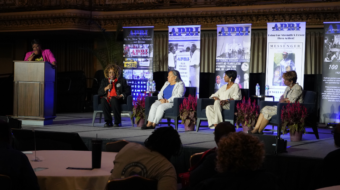TALLMANSVILLE, W. Va. –Workers at the non-union Sago mine knew the facility was unsafe, but were afraid to speak out, according to the son of one of 12 miners killed in the underground explosive accident there on Jan. 3. But while John Bennett said his father and the other miners were afraid to discuss the mine’s problems, AFL-CIO officials and federal reports counter that Sago, in rural West Virginia’s traditional coal mining area, was an extremely troubled mine. And a list published by Bush’s Mine Safety and Health Administration shows it dumped several rules four years ago that could have bettered safety at Sago.
The accident at Sago killed 12 miners underground and left a 13th in the hospital in critical condition. Lethal carbon monoxide was measured at three times the levels a person can safely breathe for a maximum of 15 minutes before succumbing. In the past two years, federal MSHA inspectors cited the Sago mine, whose present owner bought it two months ago, more than 270 times for safety violations. Many were serious—such as collapsing roofs, faulty tunnel supports, inadequate ventilation and dangerous accumulation of flammable coal dust.
“My dad would come home at night and tell me how unsafe the mine was,” John Bennett said during an early morning interview on NBC’s Today Show. His father, Jim Bennett, was among the 12 dead. John Bennett said the miners “can’t speak out about (safety problems) because the United Mine Workers is not protecting the workers anymore. We have no protection for the miners.” But that statement does not reflect that Sago is non-union. And UMWA President Cecil Roberts called the mine management’s failure to tell miners about conditions and violations at Sago “inexcusable,” the Associated Press reported.
Jim Bennett, who had worked in the mines for 30 years, was scheduled to retire in April, his son said. Several of those killed were veteran miners in their 50s and 60s. John Bennett said the families want answers and they want accountability. “A lot of us can’t understand how, in 2005, this mine could have 208 safety violations,” he said. Since October, MSHA has issued 50 citations to Sago, some as recently as Dec. 21, including citations for accumulation of combustible materials such as coal dust and loose coal. The agency said it would begin an in-depth investigation, including “how emergency information was relayed about the trapped miners’ conditions.”
Safety experts question whether an investigation will result in any change. And AFL-CIO President John J. Sweeney says the accident points up the Bush administration’s lax regard for worker safety and health, in the mines and elsewhere. “Too many workers face dangers on the job every day—not just coal miners, but construction and factory workers, service workers and office workers,” he said. Citing MSHA safety reports, Sweeney said “we don’t know if the explosion was related to the cited conditions, but it certainly is another in a long line of wake-up calls for increased government and industry attention to workers’ safety on the job.”
Jordan Barab, a former special assistant at OSHA, the Occupational Safety and Health Administration, and health and safety expert for AFSCME and the AFL-CIO, said the federal government is doing little to protect workers. He also noted 90 percent of coal mining industry campaign contributions in recent years went to Bush and the GOP. “The fact is Bush has not requested budgets for OSHA or MSHA that even keep up with the rate of inflation and mandatory pay increases over the past several years while penalties for OSHA or MSHA violations remain laughably low,” Barab writes on his website, Confined Space. “The highest penalty of the…citations received last year by Sago was $878. But that was the exception. Most of the others were $250 or $60. At that rate, it’s hardly a good business decision to even bother fixing anything. And the administration has shut down any new worker protection standards in OSHA and MSHA,” Barab wrote.
Barab did not specifically cite it but Bush’s regulatory agenda, from the Federal Register, showed the Clinton administration proposed a rule for breathing devices for underground miners, to let them breathe when the carbon monoxide escalates, as it did in Sago. Bush’s MSHA dumped the proposal in Dec. 2001. “Self-contained self-rescuers (SCSRs) are closed-circuit breathing apparatuses that provide a source of oxygen and greatly increase a miner’s chance of surviving a mine emergency involving an irrespirable atmosphere,” MSHA said then. It said mine owners reported “recent experiences with SCSRs which did not function properly or were not donned properly, rendering them ineffective.” MSHA said it was time to update the rule, requiring more-frequent replacement of SCSRs and better training. Bush’s MSHA dumped the proposal “in light of resource constraints and changing safety and health regulatory priorities.” For that reason, the same day, it dumped a Clinton proposal requiring all mines to have two separate surface exits.











